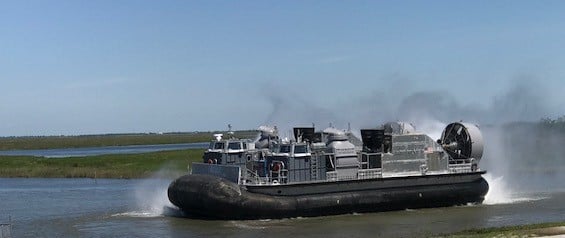
The Navy’s Ship-to-Shore Connector is moving from a developmental to a production program, with the service negotiating with Textron to build-out options on its contract, the company’s chief executive said.
Textron’s first SSC, Landing Craft Air Cushion (LCAC) 100, just finished builder’s trials and is now preparing for the Navy’s acceptance trials. LCAC 101, the second SSC, is built and currently being tested, Scott Donnelly, the chief executive of Textron, told analysts during a conference call Thursday.
“Earlier this week, we flew Craft 101, which is the second one. It did its first time on the water and ran flawlessly for over six hours and accomplished an awful lot out of the test card,” Donnelly said. “I think we feel very good about that program, which has been a challenging developmental program, transitioning now into the balance of those units.”
Textron started developing the SSC in July 2012, when the Navy awarded the firm a $212.7-million contract for the detail design and construction of the first craft with options to build eight more.
The Textron-built SSC on the outside appears very similar to the existing LCAC used by the Navy and Marine Corps to deliver personnel and equipment ashore. Textron’s SSC has a fly-by-wire control system, more powerful engines and a new drive and propulsion system, USNI News previously reported. Textron’s vessel is built with fewer parts, which is supposed to make manufacturing and maintenance easier.
However, the program experienced some delays, leaving the Navy in a situation where funds for the program were authorized but not yet spent. The result was, as Donnelly told analysts earlier this year, the Navy did not request any money for the SSC program in its Fiscal Year 2020 budget request.
In an April earnings call, Donnelly explained to investors that the Navy wanted to see progress with the program before requesting more money. According to service budget documents, the Navy requested $128 million in the FY 2017 budget for two SSCs, $212 million in the FY 2018 budget for three SSCs and $325 million in the FY 2019 budget for five SSCs.
“We’re in detailed negotiations with a customer at this point on the FY 2017, 2018, 2019 (SSCs),” Donnelly said.
Earlier this year, the House did include $84.8 million in its version of the FY 2020 National Defense Authorization Act for the SSC program. The Senate version included $40.4 million. A conference committee will determine the final funding level.
The SSC program of record calls for a total of 73 craft – one for test and training and 72 operational craft. The first deliveries were to have occurred during FY 2019, according to Naval Sea Systems Command.





